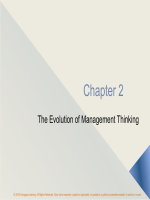Management 12e by w griffin ch07
Bạn đang xem bản rút gọn của tài liệu. Xem và tải ngay bản đầy đủ của tài liệu tại đây (1.73 MB, 42 trang )
TWELFTH EDITION
MANAGEMENT
Ricky W. Griffin
Part Three: Planning and
Decision Making
Chapter Seven: Managing
Strategy and Strategic Planning
© 2017 Cengage Learning. All rights reserved. May not be copied, scanned, or duplicated, in whole or in part, except for use as permitted
in a license distributed with a certain product or service or otherwise on a password-protected website for classroom use.
7-1
Learning Outcomes
1. Discuss the components of strategy, types of
strategic alternatives, and the distinction
between strategy formulation and strategy
implementation.
2. Describe how to use SWOT (Strengths,
Weaknesses, Opportunities, and Threats)
analysis in formulating strategy.
3. Identify and describe various alternative
approaches to business-level strategy
formulation.
© 2017 Cengage Learning. All rights reserved. May not be copied, scanned, or duplicated, in whole or in part, except for use as permitted
in a license distributed with a certain product or service or otherwise on a password-protected website for classroom use.
7-2
Learning Outcomes
4. Describe how business-level strategies are
implemented.
5. Identify and describe various alternative
approaches to corporate-level strategy
formulation.
6. Describe how corporate-level strategies are
implemented.
7. Discuss international and global strategies.
© 2017 Cengage Learning. All rights reserved. May not be copied, scanned, or duplicated, in whole or in part, except for use as permitted
in a license distributed with a certain product or service or otherwise on a password-protected website for classroom use.
7-3
Nature of Strategic Management
Strategy
• A comprehensive plan for accomplishing an organization’s goals.
Strategic management
• A comprehensive and ongoing management process aimed at
formulating and implementing effective strategies; a way of
approaching business opportunities and challenges.
Effective strategy
• A strategy that promotes a superior alignment between the
organization and its environment and the achievement of strategic
goals.
© 2017 Cengage Learning. All rights reserved. May not be copied, scanned, or duplicated, in whole or in part, except for use as permitted
in a license distributed with a certain product or service or otherwise on a password-protected website for classroom use.
7-4
Components of Strategy
Strategy
Distinctive
competence
An organizational strength
possessed by only a small number
of competing firms.
Scope
Specifies the range of markets in
which an organization will
compete.
Resource
deployment
How a firm distributes its resources
across the areas in which it
competes.
© 2017 Cengage Learning. All rights reserved. May not be copied, scanned, or duplicated, in whole or in part, except for use as permitted
in a license distributed with a certain product or service or otherwise on a password-protected website for classroom use.
7-5
© 2017 Cengage Learning. All rights reserved. May not be copied, scanned, or duplicated, in whole or in part, except for use as permitted
in a license distributed with a certain product or service or otherwise on a password-protected website for classroom use.
7-6
• The set of strategic alternatives
from which an organization
chooses as it conducts business
in a particular industry or
market.
• The set of strategic alternatives
from which an organization
chooses as it manages its
operations simultaneously
across several industries and
several markets.
Business-level strategy
Corporate-level strategy
Levels of Strategy
Strategy Formulation and Implementation
Strategy formulation
– is the set of processes involved in creating or
determining the strategies of the organization
• it focuses on the content of strategies.
Strategy implementation
– is the methods by which strategies are
executed within the organization
• it focuses on the processes which achieve
strategies.
© 2017 Cengage Learning. All rights reserved. May not be copied, scanned, or duplicated, in whole or in part, except for use as permitted
in a license distributed with a certain product or service or otherwise on a password-protected website for classroom use.
7-7
Strategy Formulation and Implementation
Deliberate strategy
– is a chosen plan of action implemented to
support specific goals.
Emergent strategy
– is a developed pattern of actions in the
absence of mission and goals or despite
mission and goals.
© 2017 Cengage Learning. All rights reserved. May not be copied, scanned, or duplicated, in whole or in part, except for use as permitted
in a license distributed with a certain product or service or otherwise on a password-protected website for classroom use.
7-8
Figure 7.1
SWOT Analysis
SWOT is an
acronym standing
for Strengths,
Weaknesses,
Opportunities,
and Threats.
© 2017 Cengage Learning. All rights reserved. May not be copied, scanned, or duplicated, in whole or in part, except for use as permitted
in a license distributed with a certain product or service or otherwise on a password-protected website for classroom use.
7-9
Using SWOT Analysis to Formulate
Strategy
Evaluating an organization’s strengths
– Organizational strengths
• are skills or capabilities enabling an organization to
conceive of and implement its strategies.
– SWOT analysis divides strengths into common
strengths and distinctive competencies.
• A common strength is a skill or capability held by
numerous competing firms.
• Competitive parity exists when large numbers of
competing firms can implement the same strategy.
© 2017 Cengage Learning. All rights reserved. May not be copied, scanned, or duplicated, in whole or in part, except for use as permitted
in a license distributed with a certain product or service or otherwise on a password-protected website for classroom use.
7 - 10
Using SWOT Analysis to Formulate
Strategy
Evaluating an organization’s strengths
– A distinctive competence is a strength
possessed by a small number of firms.
– Organizations that exploit these competencies
often obtain a competitive advantage.
– Strategic imitation is duplicating another’s
competence into a valuable strategy.
– Sustained competitive advantage exists after
all attempts at strategic imitation have ceased.
© 2017 Cengage Learning. All rights reserved. May not be copied, scanned, or duplicated, in whole or in part, except for use as permitted
in a license distributed with a certain product or service or otherwise on a password-protected website for classroom use.
7 - 11
Using SWOT Analysis to Formulate
Strategy
Evaluating an organization’s weaknesses
– Organizational weaknesses
• are skills and capabilities that do not enable (and
may limit) an organization to choose and implement
strategies that support its mission.
– Two ways to address weaknesses
• invest to obtain strengths or modify mission.
– A competitive disadvantage exists when a
firm is not implementing valuable strategies
implemented in competing firms.
© 2017 Cengage Learning. All rights reserved. May not be copied, scanned, or duplicated, in whole or in part, except for use as permitted
in a license distributed with a certain product or service or otherwise on a password-protected website for classroom use.
7 - 12
Using SWOT Analysis to Formulate
Strategy
Evaluating opportunities and threats
requires analyzing the environment.
– Organizational opportunities
• are areas in the environment that, if exploited, may
generate higher performance.
– Organizational threats
• areas in the environment that increase the difficulty
of an organization’s achieving high performance.
© 2017 Cengage Learning. All rights reserved. May not be copied, scanned, or duplicated, in whole or in part, except for use as permitted
in a license distributed with a certain product or service or otherwise on a password-protected website for classroom use.
7 - 13
Formulating Business-Level Strategies
Porter’s
Generic
Strategies
The Miles
and Snow
Typology
Product Life
Cycle
Strategies
There are three approaches to formulating
business-level strategy.
© 2017 Cengage Learning. All rights reserved. May not be copied, scanned, or duplicated, in whole or in part, except for use as permitted
in a license distributed with a certain product or service or otherwise on a password-protected website for classroom use.
7 - 14
Formulating Business-Level Strategies
Porter’s Generic Strategies
Differentiation strategy
– seeks to distinguish itself from competitors
through the quality of its products and services.
Overall cost leadership strategy
– seeks to gain a competitive advantage by
reducing its costs below competing firms.
Focus strategy
– concentrates on a specific regional market,
product line, or group of buyers.
© 2017 Cengage Learning. All rights reserved. May not be copied, scanned, or duplicated, in whole or in part, except for use as permitted
in a license distributed with a certain product or service or otherwise on a password-protected website for classroom use.
7 - 15
Table 7.1
Porter’s Generic Strategies
© 2017 Cengage Learning. All rights reserved. May not be copied, scanned, or duplicated, in whole or in part, except for use as permitted
in a license distributed with a certain product or service or otherwise on a password-protected website for classroom use.
7 - 16
Formulating Business-Level Strategies
The
Miles and Snow Typology
Prospector strategy
– encourages creativity and flexibility and is often
decentralized.
Defender strategy
– focuses on lowering costs and improving performance of
current products.
Analyzer strategy
– maintains current businesses and is somewhat innovative
in new businesses.
Reactor strategy
– has no consistent approach to strategy.
© 2017 Cengage Learning. All rights reserved. May not be copied, scanned, or duplicated, in whole or in part, except for use as permitted
in a license distributed with a certain product or service or otherwise on a password-protected website for classroom use.
7 - 17
Table 7.2
The Miles and Snow Typology
© 2017 Cengage Learning. All rights reserved. May not be copied, scanned, or duplicated, in whole or in part, except for use as permitted
in a license distributed with a certain product or service or otherwise on a password-protected website for classroom use.
7 - 18
Figure 7.2
The Product Life Cycle
© 2017 Cengage Learning. All rights reserved. May not be copied, scanned, or duplicated, in whole or in part, except for use as permitted
in a license distributed with a certain product or service or otherwise on a password-protected website for classroom use.
7 - 19
Formulating Business-Level Strategies
Product life cycle
– is a model portraying how sales volume for
products change over the life of the product.
• Different stages call for different strategies.
– Introduction stage
• Demand may be very high.
• Focus on increasing production, keeping quality
high, and managing inventories and cash flow.
© 2017 Cengage Learning. All rights reserved. May not be copied, scanned, or duplicated, in whole or in part, except for use as permitted
in a license distributed with a certain product or service or otherwise on a password-protected website for classroom use.
7 - 20
Formulating Business-Level Strategies
Product life cycle
– Growth stage
• Sales continue to grow.
• Focus on quality/delivery and begin to differentiate.
– Maturity stage
• Demand begins to slow.
• Focus on low costs and search for new products.
– Decline stage
• Total sales decline.
• Firms may close, or differentiate and cut costs.
© 2017 Cengage Learning. All rights reserved. May not be copied, scanned, or duplicated, in whole or in part, except for use as permitted
in a license distributed with a certain product or service or otherwise on a password-protected website for classroom use.
7 - 21
Implementing Business-Level Strategies
Porter’s Generic Strategies
Differentiation strategy
– Marketing and sales emphasizes high-quality,
high-value image of products or services.
– Accounting controls the flow of funds without
discouraging creativity.
– Manufacturing emphasizes quality and
meeting customer needs.
– The culture must emphasize creativity,
innovation, and response to customer needs.
© 2017 Cengage Learning. All rights reserved. May not be copied, scanned, or duplicated, in whole or in part, except for use as permitted
in a license distributed with a certain product or service or otherwise on a password-protected website for classroom use.
7 - 22
Implementing Business-Level Strategies
Porter’s Generic Strategies
Overall cost leadership strategy
– Marketing focuses on product attributes meeting
customer needs in a low-cost, effective manner.
– Accounting reduces costs through tight controls.
– Manufacturing reduces per unit costs by
increasing volume of production.
– Culture focuses on improving efficiencies.
© 2017 Cengage Learning. All rights reserved. May not be copied, scanned, or duplicated, in whole or in part, except for use as permitted
in a license distributed with a certain product or service or otherwise on a password-protected website for classroom use.
7 - 23
Implementing Business-Level Strategies
The
Miles and Snow’s Strategies
Decentralization facilitates prospectors.
– Encourages creativity and flexibility.
– Prospectors often switch to defenders.
Defenders downplay creativity, focusing on
costs and improving performance.
Analyzers maintain current business and
must be somewhat innovative.
– Tight financial controls and high flexibility,
efficient production and customized products.
© 2017 Cengage Learning. All rights reserved. May not be copied, scanned, or duplicated, in whole or in part, except for use as permitted
in a license distributed with a certain product or service or otherwise on a password-protected website for classroom use.
7 - 24
Formulating Corporate-Level Strategies
Each business within
such a firm is frequently
called a strategic
business unit, or SBU.
Most large businesses
are engaged in several
businesses, industries,
and markets.
Diversification is the number of different businesses
an organization engages in and the extent to which
these businesses are related to each other.
© 2017 Cengage Learning. All rights reserved. May not be copied, scanned, or duplicated, in whole or in part, except for use as permitted
in a license distributed with a certain product or service or otherwise on a password-protected website for classroom use.
7 - 25









